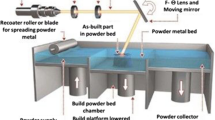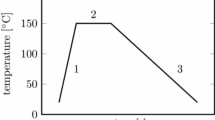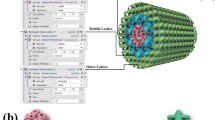Abstract
Background
Fiber-metal laminates (FML) are seeing increasing application in the aerospace industry due to their potential for significant weight reduction in structural design. Residual stresses develop through the thickness of a FML resulting from the production process.
Objective
To assess and validate the latest calculation procedures for residual stress determination in FMLs by IHD. The two methods in focus are advancements of methods previously developed for isotropic materials. The first is based on the so-called integral method using Tikhonov regularization, similar to that of the ASTM E837 standard, and the second is based on the power series approach, similar to that proposed by Schajer in the 80’s.
Methods
Hybrid FML samples were specifically designed to allow the use of neutron diffraction to complement analyses performed using the two IHD calculation techniques. A symmetric FML with a ply stacking configuration of glass fiber-reinforced polymer (GFRP) and steel [0/90/steel]s was selected. The neutron diffraction analyses were performed on the steel core (which is not possible on the non-crystalline GFRP plies).
Results
The residual stresses determined by both IHD methods compare well and both can characterise the distribution of residual stresses through each layer of the structure, clearly identifying the discontinuities occurring at the interfaces. The error sensitivity of the power series approach is somewhat lower compared to that of the integral one.
Conclusions
The IHD residual stresses determined in the inner metallic layer compare well with those determined by neutron diffraction.











Similar content being viewed by others
Change history
21 June 2022
A Correction to this paper has been published: https://doi.org/10.1007/s11340-022-00865-3
References
Sinmazçelik T, Avcu E, Bora MÖ, and Çoban O (2011) A review: Fibre metal laminates, background, bonding types and applied test methods. Mater Des 32(7):3671–3685. ISSN 0261-3069. https://doi.org/10.1016/j.matdes.2011.03.011
Vlot A, Gunnink JW (2001) Fibre Metal Laminates. Springer Netherlands. https://doi.org/10.1007/978-94-010-0995-9
Roebroeks GHJJ (1994) Fibre-metal laminates: Recent developments and applications. Int J Fatigue 16(1):33–42. ISSN 0142-1123. https://doi.org/10.1016/0142-1123(94)90443-X
Wittenberg TC, van Baten TJ, and de Boer A (2001) Design of fiber metal laminate shear panels for ultra-high capacity aircraft. Aircr Des 4(2):99–113. ISSN 1369-8869. https://doi.org/10.1016/S1369-8869(01)00003-9
Botelho EC, Silva RA, Pardini LC, Rezende MC (2006) A review on the development and properties of continuous fiber/epoxy/aluminum hybrid composites for aircraft structures. Mater Res 9:247–256. https://doi.org/10.1590/S1516-14392006000300002
Ding Z, Wang H, Luo J, Li N (2021) A review on forming technologies of fibre metal laminates. Int J Lightweight Mater Manuf 4(1):110–126. ISSN 2588-8404. https://doi.org/10.1016/j.ijlmm.2020.06.006
Prussak R, Stefaniak D, Hühne C, Sinapius M (2018) Evaluation of residual stress development in FRP-metal hybrids using fiber Bragg grating sensors. Prod Eng Res Devel 12(2):259–267. https://doi.org/10.1007/s11740-018-0793-4
Zhao L, Warrior NA, Long AC (2007) Analysis of residual stress in fibre-reinforced polymer composites. In: Proceedings of the 16th International Conference on Composite Materials, Kyoto, Japan, July 8–13 2007
Withers PJ, Bhadeshia HKDH (2001) Residual stress. Part 1 - Measurement techniques. Mater Sci Technol 17(4):355–365. https://doi.org/10.1179/026708301101509980
Schajer GS, Whitehead PS (2018) Hole-drilling method for measuring residual stresses, vol 1. Morgan & Claypool Publishers. https://doi.org/10.2200/S00818ED1V01Y201712SEM001
ASTM E837-20 (2020) Standard test method for determining residual stresses by the hole-drilling strain-gage method. ASTM International, West Conshohocken, PA. www.astm.org
Schajer GS, Yang L (1994) Residual-stress measurement in orthotropic materials using the hole-drilling method. Exp Mech 34(4):324–333. ISSN 00144851. https://doi.org/10.1007/BF02325147
Ghasemi AR, Mohammadi MM (2016) Residual stress measurement of fiber metal laminates using incremental hole-drilling technique in consideration of the integral method. Int J Mech Sci 114:246–256. ISSN 0020-7403. https://doi.org/10.1016/j.ijmecsci.2016.05.025
Smit TC, Reid RG (2018) Residual stress measurement in composite laminates using incremental hole-drilling with power series. Exp Mech 58(8):1221–1235. ISSN 17412765. https://doi.org/10.1007/s11340-018-0403-6
Bijak-Zochowski M (1978) A semi-destructive method of measuring residual stresses. VDI-Berichte 313:469–476
Schajer GS (1988a) Measurement of non-uniform residual stresses using the hole-drilling method. Part I–Stress calculation procedures. J Eng Mater Technol 110(4):338–343. ISSN 0094-4289. https://doi.org/10.1115/1.3226059
Schajer GS (1988b) Measurement of non-uniform residual stresses using the hole-drilling method. Part II. Practical application of the integral method. Journal of Engineering Materials and Technology, Transactions of the ASME 110(4):344–349. ISSN 00944289. https://doi.org/10.1115/1.3226059
Schajer GS (1981) Application of finite element calculations to residual stress measurements. J Eng Mater Technol 103(2):157. ISSN 00944289. https://doi.org/10.1115/1.3224988
Sicot O, Gong XL, Cherouat A, Lu J (2003) Determination of residual stress in composite laminates using the incremental hole-drilling method. J Compos Mater 37(9):831–844. ISSN 0021-9983. https://doi.org/10.1177/002199803031057
Niku-Lari A, Lu J, Flavenot JF (1985) Measurement of residual-stress distribution by the incremental hole-drilling method. J Mech Work Technol 11(2):167–188. ISSN 03783804. https://doi.org/10.1016/0378-3804(85)90023-3
Pagliaro P, Zuccarello B (2007) Residual stress analysis of orthotropic materials by the through-hole drilling method. Exp Mech 47(2):217–236. ISSN 00144851. https://doi.org/10.1007/s11340-006-9019-3
Reddy JN (1987) A generalization of two-dimensional theories of laminated composite plates. Communications in Applied Numerical Methods 3(3):173–180. https://doi.org/10.1002/cnm.1630030303
Akbari S, Taheri-Behrooz F, Shokrieh MM (2014) Characterization of residual stresses in a thin-walled filament wound carbon/epoxy ring using incremental hole drilling method. Combust Sci Technol 94:8–15. ISSN 02663538. https://doi.org/10.1016/j.compscitech.2014.01.008
Shokrieh MM, Ghasemi ARK 2007 Determination of calibration factors of the hole drilling method for orthotropic composites using an exact solution. J Compos Mater 41(19):2293–2311. ISSN 00219983. https://doi.org/10.1177/0021998307075443
Shokrieh MM, Ghasemi ARK (2007) Simulation of central hole drilling process for measurement of residual stresses in isotropic, orthotropic, and laminated composite plates. J Compos Mater 41(4):435–452. ISSN 00219983 1530793X. https://doi.org/10.1177/0021998306063803
Magnier A, Wu T, Tinkloh SR, Tröster T, Scholtes B, Niendorf T (2021) On the reliability of residual stress measurements in unidirectional carbon fibre reinforced epoxy composites. Polym Test 97:107146. ISSN 0142-9418. https://doi.org/10.1016/j.polymertesting.2021.107146
Wu T, Tinkloh SR, Tröster T, Zinn W, Niendorf T (2020) Determination and validation of residual stresses in CFRP/metal hybrid components using the incremental hole drilling method. J Comput Sci 4(3). ISSN 2504-477X. https://doi.org/10.3390/jcs4030143
Tinkloh SR, Wu T, Tröster T, Niendorf T (2020) A micromechanical-based finite element simulation of process-induced residual stresses in metal-CFRP-hybrid structures. Compos Struct 238:111926. ISSN 0263-8223. https://doi.org/10.1016/j.compstruct.2020.111926
Schajer GS, Prime MB (2006) Use of inverse solutions for residual stress measurements. J Eng Mater Technol 128(3):375. ISSN 00944289. https://doi.org/10.1115/1.2204952
Smit TC, Reid RG (2020) Tikhonov regularization with incremental hole-drilling and the integral method in cross-ply composite laminates. Exp Mech 60(8):1135–1148. ISSN 17412765. https://doi.org/10.1007/s11340-020-00629-x
Schajer GS (2007) Hole-drilling residual stress profiling with automated smoothing. J Eng Mater Technol 129(3):440–445. ISSN 0094-4289. https://doi.org/10.1115/1.2744416
ASTM E837-13 (2013) Standard test method for determining residual stresses by the hole-drilling strain-gage method. ASTM International, West Conshohocken, PA. www.astm.org
Nau A, Scholte B, Rohleder M, Nobre JP (2011) Application of the hole drilling method for residual stress analyses in components made of polycarbonate. Journal of Plastics Technology 3:66–85
Magnier A, Scholtes B, Niendorf T (2017) Analysis of residual stress profiles in plastic materials using the hole drilling method-influence factors and practical aspects. Polym Testing 59(Complete):29–37. https://doi.org/10.1016/j.polymertesting.2016.12.025
Nobre JP, Stiffel JH, Nau A, Outeiro JC, Batista AC, Van Paepegem W, Scholtes B (2013) Induced drilling strains in glass fibre reinforced epoxy composites. CIRP Annals 62(1):87–90. ISSN 0007-8506. https://doi.org/10.1016/j.cirp.2013.03.089
Schajer GS, Altus E (1996) Stress calculation error analysis for incremental hole-drilling residual stress measurements. Journal of Engineering Materials and Technology-Transactions of the ASME 118(1):120–126. ISSN 0094-4289. https://doi.org/10.1115/1.2805924
Zuccarello B (1999) Optimal calculation steps for the evaluation of residual stress by the incremental hole-drilling method. Exp Mech 39(2):117–124. ISSN 0014-4851. https://doi.org/10.1007/BF02331114
Prime MB, Crane DL (2014) Slitting method measurement of residual stress profiles, including stress discontinuities, in layered specimens. Conference Proceedings of the Society for Experimental Mechanics Series 8:93–102. https://doi.org/10.1007/978-3-319-00876-9_12
Tikhonov AN, Goncharsky AV, Stepanov VV, Yagola AG (1995) Numerical Methods for the Solution of Ill-Posed Problems. Kluwer, Dordrecht
Akbari S, Taheri-Behrooz F, Shokrieh MM (2013) Slitting measurement of residual hoop stresses through the wall-thickness of a filament wound composite ring. Exp Mech 53:1509–1518. https://doi.org/10.1007/s11340-013-9768-8
Prime MB, Hill MR (2006) Uncertainty, model error, and order selection for series-expanded, residual-stress inverse solutions. J Eng Mater Technol 128(2):175. ISSN 00944289. https://doi.org/10.1115/1.2172278
Lauter C, Tröster T, Reuter C (2013) Hybrid structures consisting of sheet metal and fibre reinforced plastics for structural automotive applications, chapter 7. John Wiley & Sons, Ltd., pp 149–174. ISBN 9781118535288. https://doi.org/10.1002/9781118535288.ch7
Wu T, Tinkloh S, Tröster T, Zinn W, Niendorf T (2021) Measurement and analysis of residual stresses and warpage in fiber reinforced plastic and hybrid components. Metals 11(2). ISSN 2075-4701. https://doi.org/10.3390/met11020335
Venter AM, van Heerden PR, Marais D, Raaths JC (2018) MPISI: The neutron strain scanner materials probe for internal strain investigations at the SAFARI-1 research reactor. Phys B Condens Matter 551:417–421. ISSN 0921-4526. https://doi.org/10.1016/j.physb.2017.12.011. The 11th International Conference on Neutron Scattering (ICNS 2017)
Wimpory RC, Hofmann M (2018) Use of symmetry for residual stress determination. In: Materials Research Proceedings, vol 6. pp 9–14. https://doi.org/10.21741/9781945291890-2
Marais D, Venter AM, Luzin V (2018) Alignment and Calibration Procedures of the Necsa Neutron Strain Scanner. In: Materials Research Proceedings, vol 4. pp 143–148. https://doi.org/10.21741/9781945291678-22
Marais D, Venter AM, Markgraaff J (2016) Optimization of counting time using count statistics on a diffraction beamline. Nuclear Instruments and Methods in Physics Research Section A: Accelerators, Spectrometers, Detectors and Associated Equipment 818:32–37. ISSN 0168-9002. https://doi.org/10.1016/j.nima.2016.02.035
Schajer GS (1993) Use of displacement data to calculate strain gauge response in non-uniform strain fields. Strain 29(1):9–13. https://doi.org/10.1111/j.1475-1305.1993.tb00820.x
Vishay Precision Group (2011) Errors due to transverse sensitivity in strain gages, Tech Note TN-509. Technical report
BIPM, IEC, IFCC, ILAC, IUPAC, IUPAP, ISO, OIML (2008) Evaluation of measurement data—Supplement 1 to the “Guide to the expression of uncertainty in measurement”—Propagation of distributions using a Monte Carlo method. JCGM 101:2008
Peral D, de Vicente J, Porro JA, Ocaña JL (2017) Uncertainty analysis for non-uniform residual stresses determined by the hole drilling strain gauge method. Meas: J Int Meas Confed 97:51–63. ISSN 02632241. https://doi.org/10.1016/j.measurement.2016.11.010
Flaggs DL, Kural MH (1982) Experimental determination of the in situ transverse lamina strength in graphite/epoxy laminates. J Compos Mater 16(2):103–116. https://doi.org/10.1177/002199838201600203
Acknowledgements
The authors would like to acknowledge the financial support of the German Research Foundation (DFG - Deutsche Forschungsgemeinschaft) under the scope of the research project number 399304816. Professor T. Tröster and his group at University of Paderborn (Automotive Lightweight Design, (LiA) are thanked for providing the materials. Necsa is thanked for the availability and access to the MPISI neutron strain scanner, as well as assistance by personnel.
Author information
Authors and Affiliations
Corresponding author
Ethics declarations
Informed Consent
Not applicable.
Research Involving Human and Animal Participants
Not applicable.
Conflicts of Interest
The authors declare that they have no conflict of interest.
Additional information
Publisher’s Note
Springer Nature remains neutral with regard to jurisdictional claims in published maps and institutional affiliations.
This article is updated to include the proof corrections given by corresponding author with regard to authors affiliations(2 and 3), figures(Fig.3 and Fig.9) and grammatical corrections which were missed during the production process.
Rights and permissions
About this article
Cite this article
Smit, T.C., Nobre, J.P., Reid, R.G. et al. Assessment and Validation of Incremental Hole-Drilling Calculation Methods for Residual Stress Determination in Fiber-Metal Laminates. Exp Mech 62, 1289–1304 (2022). https://doi.org/10.1007/s11340-022-00848-4
Received:
Accepted:
Published:
Issue Date:
DOI: https://doi.org/10.1007/s11340-022-00848-4




